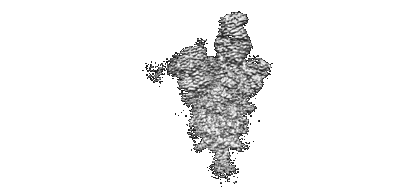EMD-34038
SARS-CoV-2 BA.2.75 S Trimer in complex with S309 (state1)
EMD-34038
Single-particle3.72 Å
 Deposition: 08/08/2022
Deposition: 08/08/2022Map released: 19/10/2022
Last modified: 06/11/2024
Sample Organism:
Homo sapiens,
Severe acute respiratory syndrome coronavirus 2
Sample: BA.2.75 S trimer in complex with S309
Fitted models: 7yqx (Avg. Q-score: 0.353)
Deposition Authors: Wang L
Sample: BA.2.75 S trimer in complex with S309
Fitted models: 7yqx (Avg. Q-score: 0.353)
Deposition Authors: Wang L
Characterization of the enhanced infectivity and antibody evasion of Omicron BA.2.75.
Cao Y  ,
Song W,
Wang L,
Liu P,
Yue C,
Jian F
,
Song W,
Wang L,
Liu P,
Yue C,
Jian F  ,
Yu Y,
Yisimayi A,
Wang P,
Wang Y,
Zhu Q,
Deng J,
Fu W,
Yu L,
Zhang N
,
Yu Y,
Yisimayi A,
Wang P,
Wang Y,
Zhu Q,
Deng J,
Fu W,
Yu L,
Zhang N  ,
Wang J,
Xiao T,
An R,
Wang J,
Liu L,
Yang S
,
Wang J,
Xiao T,
An R,
Wang J,
Liu L,
Yang S  ,
Niu X,
Gu Q,
Shao F,
Hao X,
Meng B,
Gupta RK,
Jin R,
Wang Y,
Xie XS,
Wang X
,
Niu X,
Gu Q,
Shao F,
Hao X,
Meng B,
Gupta RK,
Jin R,
Wang Y,
Xie XS,
Wang X
(2022) Cell Host Microbe , 30 , 1527
 ,
Song W,
Wang L,
Liu P,
Yue C,
Jian F
,
Song W,
Wang L,
Liu P,
Yue C,
Jian F  ,
Yu Y,
Yisimayi A,
Wang P,
Wang Y,
Zhu Q,
Deng J,
Fu W,
Yu L,
Zhang N
,
Yu Y,
Yisimayi A,
Wang P,
Wang Y,
Zhu Q,
Deng J,
Fu W,
Yu L,
Zhang N  ,
Wang J,
Xiao T,
An R,
Wang J,
Liu L,
Yang S
,
Wang J,
Xiao T,
An R,
Wang J,
Liu L,
Yang S  ,
Niu X,
Gu Q,
Shao F,
Hao X,
Meng B,
Gupta RK,
Jin R,
Wang Y,
Xie XS,
Wang X
,
Niu X,
Gu Q,
Shao F,
Hao X,
Meng B,
Gupta RK,
Jin R,
Wang Y,
Xie XS,
Wang X
(2022) Cell Host Microbe , 30 , 1527
Abstract:
Recently emerged SARS-CoV-2 Omicron subvariant, BA.2.75, displayed a growth advantage over circulating BA.2.38, BA.2.76, and BA.5 in India. However, the underlying mechanisms for enhanced infectivity, especially compared with BA.5, remain unclear. Here, we show that BA.2.75 exhibits substantially higher affinity for host receptor angiotensin-converting enzyme 2 (ACE2) than BA.5 and other variants. Structural analyses of BA.2.75 spike shows its decreased thermostability and increased frequency of the receptor binding domain (RBD) in the "up" conformation under acidic conditions, suggesting enhanced low-pH-endosomal cell entry. Relative to BA.4/BA.5, BA.2.75 exhibits reduced evasion of humoral immunity from BA.1/BA.2 breakthrough-infection convalescent plasma but greater evasion of Delta breakthrough-infection convalescent plasma. BA.5 breakthrough-infection plasma also exhibits weaker neutralization against BA.2.75 than BA.5, mainly due to BA.2.75's distinct neutralizing antibody (NAb) escape pattern. Antibody therapeutics Evusheld and Bebtelovimab remain effective against BA.2.75. These results suggest BA.2.75 may prevail after BA.4/BA.5, and its increased receptor-binding capability could support further immune-evasive mutations.
Recently emerged SARS-CoV-2 Omicron subvariant, BA.2.75, displayed a growth advantage over circulating BA.2.38, BA.2.76, and BA.5 in India. However, the underlying mechanisms for enhanced infectivity, especially compared with BA.5, remain unclear. Here, we show that BA.2.75 exhibits substantially higher affinity for host receptor angiotensin-converting enzyme 2 (ACE2) than BA.5 and other variants. Structural analyses of BA.2.75 spike shows its decreased thermostability and increased frequency of the receptor binding domain (RBD) in the "up" conformation under acidic conditions, suggesting enhanced low-pH-endosomal cell entry. Relative to BA.4/BA.5, BA.2.75 exhibits reduced evasion of humoral immunity from BA.1/BA.2 breakthrough-infection convalescent plasma but greater evasion of Delta breakthrough-infection convalescent plasma. BA.5 breakthrough-infection plasma also exhibits weaker neutralization against BA.2.75 than BA.5, mainly due to BA.2.75's distinct neutralizing antibody (NAb) escape pattern. Antibody therapeutics Evusheld and Bebtelovimab remain effective against BA.2.75. These results suggest BA.2.75 may prevail after BA.4/BA.5, and its increased receptor-binding capability could support further immune-evasive mutations.
